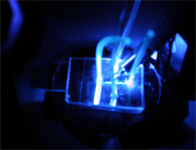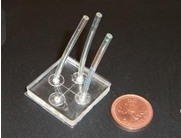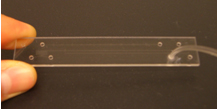
|

|

|
Lab-On-a-Chip (LOC)
In-situ medical diagnosis and Point-of-Care (POC) testing necessitates the development of fully integrated Lab-on-a-chip type devices for several practical and readily available in-vitro and in-vivo biosensing applications and bio-detections of protein-protein interactions, antigen-antibody non-covalent binding, DNA analysis etc. Microfluidics is an essential component of a biosensor unit because of the inherent advantages, such as smaller reagent volume handling, transportation and above all, the importance of introducing the biological element into the biosensor system in a controlled manner. Lab on a chips have been developed for the fluorescence and absorbance based bio-detection on silicon, glass and polymer platforms. These portable microfluidic systems have a great potential to integrate all stages of analysis in a single chip with very high accuracy and sensitivity for various point-of-care (POC) diagnosis applications.

Lab-on-a-Chip on Silicon platform.
|

PDMS based LOC.
|

LOC on glass platform.
|
Integrated LOC systems

|
Organic electroluminescent diodes (OLED) are widely used for the fabrication of displays. In addition to this specific application, organic semiconductors could be used to build various other electronic, photonic and spintronic devices. One of the advantages of organic semiconductors is the ease in which they can be deposited into large areas. The polymer microfluidic chip was hybrid integrated with OLED.
Hybrid Integrated LOC systems:
Polymer based interconnection technology was developed in order to hybrid integrate the microfluidic input/output connections and optical fibers connected with input light source and spectrometer on chip. Figure shows a packaged microfluidic chip with input/output waveguides.
|

|

|

|
|
|





